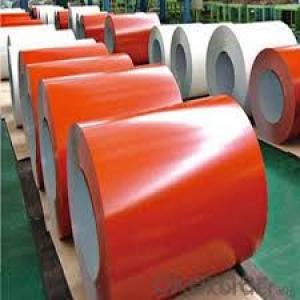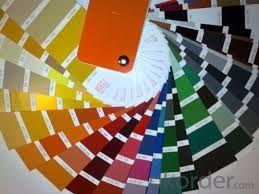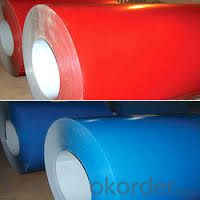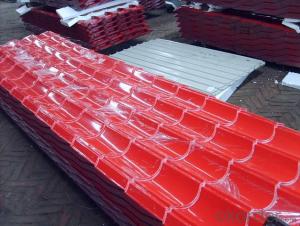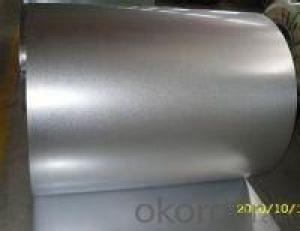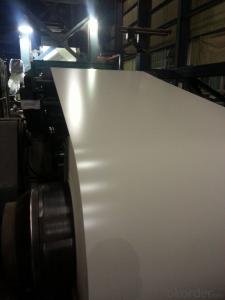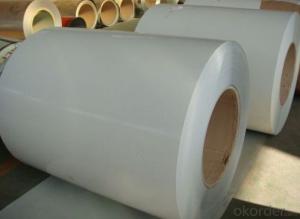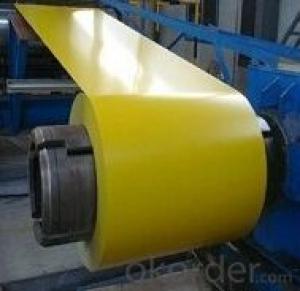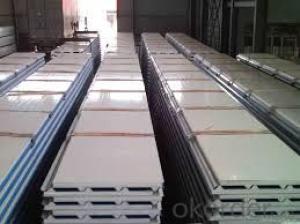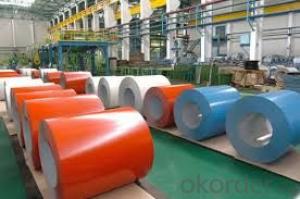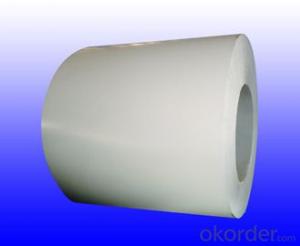PPGI/Pre-Painted Galvanized (PPGI) Color Coated Steel Coil
- Loading Port:
- China main port
- Payment Terms:
- TT OR LC
- Min Order Qty:
- 25 m.t.
- Supply Capability:
- 1000 m.t./month
OKorder Service Pledge
OKorder Financial Service
You Might Also Like
Product Description
Pre-painted Galvanized Steel Coil
PPGI is made by cold rolled steel sheet and galvanized steel sheets as baseplate,
Through the surface pretreatment (degreasing, cleaning, chemical conversion
Processing), coated by the method of continuous coatings (roller coating method),
And after roasting and cooling.
SPECIFICATION
1. Standard: AISI, ASTM, BS, DIN, GB, JIS
2. Grade: DX51D+Z, DC51D, SPCC, SGCC, SGHC, CGCC,
3. Surface Treatment Coated: Galvanized, Paint sealant, Coating passivation solution
Substrate Cold rolled, Galvanized sheet
4. Color: RAL Color card
5. Coil ID: 508/610 mm
6. Coil weight: 4-10MT
7. Paint film Front side: 10~25um
Back side: 5~10um
8. Zinc layer: 40~180g per square meter
9. Thickness: 0.14~3.0mm
10. Width: 400~1500mm
11. Length: As requirement
12. Type: Steel plate, Steel Coil, Roofing metal
13. Place of origin: Shandong CHINA(mainland)
14. Deliver time: 20-30 days after receipt of advanced t/t or L/C
Advantages
1. Our company produce various specification and models and national standards of galvanized steel coil
2. Using high-quality material and advanced production technology and equipment for processing
3. Applicable to a humid climate and the harsh corrosive environment
4. Products has been all over the country more than 20 provinces, municipalities and
Autonomous regions, and have been exported to Europe, North American, the Middle East,
The South East Asia, Africa, Asia, European and other countries and regions, well received by our buyer.
commodity | Color-coated Galvanized Steel Coil (PPGI/ PPGL) |
Techinical Standard: | JIS G3302-1998, EN10142/10137, ASTM A653 |
grade | TSGCC, TDX51D / TDX52D / TS250, 280GD |
Types: | For general / drawing use |
Thickness | 0.14-2.0mm(0.16-0.8mm is the most advantage thickness)) |
Width | Width: 610/724/820/914/1000/1200/1219/1220/1250mm |
Type of coating: | PE, SMP, PVDF |
Zinc coating | Z60-150g/m2 or AZ40-100g/m2 |
Top painting: | 5 mic. Primer + 15 mc. R. M. P. |
Back painting: | 5-7 mic. EP |
Color: | According to RAL standard |
ID coil | 508mm / 610mm |
Coil weight: | 4--8MT |
Package: | Properly packed for ocean freight exportation in 20' ' containers |
Application: | Industrial panels, roofing and siding for painting / automobile |
Price terms | FOB, CFR, CIF |
Payment terms | 20%TT in advance+80% TT or irrevocable 80%L/C at sight |
delivery time | 25 days after recepit of 20% TT |
Remarks | Insurance is all risks |
MTC 3.1 will be handed on with shipping documents | |
We accept SGS certificatation test |
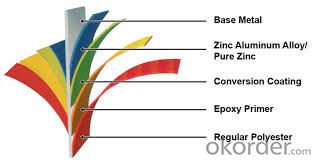
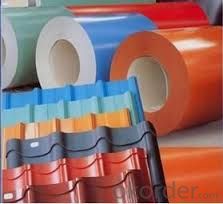
- Q: How many pounds can steel lift?
- I think that you failed to put up a meaningful question. I suggest that you try again and seek help.
- Q: How are steel coils used in the oil and gas industry?
- Steel coils are used in the oil and gas industry for various purposes such as pipelines, storage tanks, and drilling equipment. These coils are commonly used to manufacture seamless and welded pipes that are essential for transporting oil and gas from production sites to refineries and end-users. Additionally, steel coils are utilized in the construction of storage tanks that store oil and gas in large quantities. They are also an integral part of drilling equipment, including offshore platforms, where they provide structural support and withstand high-pressure environments.
- Q: Classify the following in as many ways as possible:stainless steelpureheterogeneous mixturehomogeneous mixturenone of these
- Stainless steel is an iron-carbon alloy that contains about 13% chromium. There are 3 types, each of which have different properties depending on what ingredient is added and these are...nickel, carbon, and manganese... Stainless steal is homogeneous in that you only see one phase (steel) and none of the different parts from which it is made...
- Q: How are steel coils used in the production of steel tanks?
- Steel coils are an essential component in the production of steel tanks. These coils, which are typically made from high-quality steel, serve as the primary raw material for manufacturing steel tanks. The first step in the process is to unroll and flatten the steel coils, which are usually delivered in a coiled form from the steel mills. Once the coils are unrolled, they are then cut into specific lengths and widths, depending on the desired dimensions of the steel tank. These cut pieces are then molded and shaped into the different components of the tank, such as the cylindrical body, the top and bottom ends, and any additional fittings or accessories. The steel coils provide the necessary strength and durability to the tank, ensuring that it can withstand the rigors of its intended application. The quality of the steel used in the coils is crucial, as it determines the tank's resistance to corrosion, pressure, and external forces. Moreover, the use of steel coils allows for efficient and cost-effective production of steel tanks. The standardized nature of the coils ensures consistent quality and dimensions, resulting in a streamlined manufacturing process. The ability to cut the coils into precise lengths and widths also minimizes wastage and maximizes material utilization. Furthermore, steel coils offer flexibility in terms of design and customization. They can be easily formed and welded into complex shapes, allowing for the creation of tanks with varying sizes, capacities, and configurations. This versatility makes steel coils an ideal choice for producing tanks for diverse sectors, including industrial, commercial, and residential applications. In summary, steel coils play a crucial role in the production of steel tanks. They provide the necessary raw material for manufacturing various tank components, ensuring strength, durability, and customization. By utilizing steel coils, manufacturers can efficiently produce high-quality tanks that meet the specific requirements of different industries.
- Q: What is the weight of a typical steel coil?
- The weight of a typical steel coil can vary significantly depending on its size, thickness, and type of steel used. However, a typical steel coil can range anywhere from a few hundred kilograms to several tonnes in weight.
- Q: How are steel coils used in the manufacturing of metal furniture?
- Steel coils are used in the manufacturing of metal furniture as they provide the raw material for forming different components, such as frames, legs, and support structures. These coils are processed and shaped through various manufacturing techniques like cutting, bending, and welding to create the desired furniture pieces. The strength, durability, and versatility of steel make it an ideal material for metal furniture, ensuring stability and longevity in the final products.
- Q: How are steel coils inspected for color consistency?
- To ensure that the final product meets the desired specifications, various methods are used to inspect the color consistency of steel coils. Visual inspection, which involves trained inspectors examining the coils under controlled lighting conditions, is one common method. By comparing the color of each coil to a standard color chart or a previously approved sample, any variations in color can be detected and noted for further analysis. In addition, objective color measurement can be achieved using advanced technologies such as spectrophotometers. These devices measure the reflective properties of the steel surface using light, allowing for precise color analysis. The obtained color data is then compared to the specified color range, and any deviations are flagged for further investigation. Furthermore, some manufacturers may opt for automated color measurement systems, such as colorimeters or color cameras, to inspect steel coils for color consistency. These systems provide quick and accurate assessments of the color of each coil, ensuring uniformity throughout the entire batch. Overall, the inspection process for color consistency in steel coils combines visual inspection, spectrophotometry, and automated color measurement systems. This comprehensive approach guarantees that the steel coils meet the required color standards, resulting in consistent and high-quality products for customers.
- Q: any one have an opinion? i've heard steel cut oatmeal is better for you...
- This Site Might Help You. RE: what's the difference between natural rolled oats oatmeal and steel cut oatmeal? any one have an opinion? i've heard steel cut oatmeal is better for you...
- Q: What are the common uses of cold rolled steel coils?
- Cold rolled steel coils are commonly used in a variety of industries and applications. Some of the common uses include manufacturing automotive parts, appliances, construction materials, and electrical components. The cold rolling process provides the steel with a smoother surface finish, improved strength, and better dimensional accuracy, making it suitable for various manufacturing purposes.
- Q: Is it possible to make a homemade blacksmith forge from a washing machine drum made of stainless steel?
- The okorder /
Send your message to us
PPGI/Pre-Painted Galvanized (PPGI) Color Coated Steel Coil
- Loading Port:
- China main port
- Payment Terms:
- TT OR LC
- Min Order Qty:
- 25 m.t.
- Supply Capability:
- 1000 m.t./month
OKorder Service Pledge
OKorder Financial Service
Similar products
Hot products
Hot Searches
Related keywords
